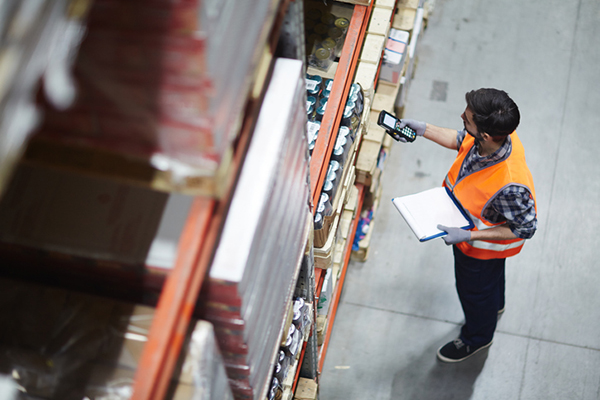Top 20 automatic identification and data capture suppliers 2019
As the modern warehouse continues to evolve, ADC equipment and the companies that develop it are playing pivotal roles in its progression.
As warehouses and DCs evolve into more automated, tech-enabled spaces, demand for the tools, applications and equipment that support the shift continues to rise.
Comprising equipment (i.e., handheld rugged mobile computers; vehicle-mounted computers; handheld and stationary bar code scanners; and thermal label printers) and mobile solutions (mobile bar code scanners and wearable computers), automatic identification and data capture solutions (AIDC) are playing a vital role in the evolution of the modern warehouse.
The Top 20 players
For this year’s AIDC Top 20 report, VDC Research tracked significant revenue increases for nearly all of the companies that made the list.
Some reported revenue increases of 50% to 100% over the last 12 months, while others posted double-digit increases for their product lines. Only one company reported a revenue loss in the AIDC sector, compared to the eight companies that reported negative revenue growth in 2018 (compared to 2017).
The top players have maintained rankings on VDC’s chart, with Zebra Technologies, Honeywell, Datalogic and SATO holding the top four positions.
Moving up two notches was Cognex, which took over the fifth spot and knocked Toshiba TEC (which posted the only negative revenue growth on the entire chart) into sixth place. Denso Wave, Panasonic, TSC Printers and Fujian Newland rounded out the top 10 spots on the chart.
New entrants on this year’s list include Keyence, which makes automation sensors, vision systems, bar code readers, and laser markers; Vitronic, a maker of industrial machine vision solutions; and Omron, whose products include control equipment and factory automation systems.
The reshuffling of the order plus the newcomers effectively knocked several companies out of the running for the Top 20, including M3 Mobile, Optoelectronics Co. and NCR.
Top 20 ADC Suppliers
|
2019 Rank | 2018 Rank | Company Name | 2019 Revenues (USD, in millions) | 2018 Revenues (USD, in millions) | Year over Year | North American Headquarters |
|
1 | 1 | 2503.8 | 2231 | 12.2% | Lincolnshire, Ill. | |
2 | 2 | 888.9 | 709 | 25.3% | Morristown, N.J. | |
3 | 3 | 625.2 | 554 | 12.9% | Eugene, Ore. |
|
4 | 4 | 229 | 219 | 4.6% | Charlotte, N.C. | |
5 | 7 | https://www.cognex.com/”>Cognex | 175.3 | 114 | 53.8% | Natick, Mass. |
6 | 5 | 171.8 | 173 | -0.8% | Irvine, Calif. | |
7 | 6 | 137.8 | 122 | 12.6% | Southfield, Mich. | |
8 | 14 | 126.3 | 61 | 105.7% | Newark, N.J. | |
9 | 9 | 113.6 | 86 | 32.6% | Pomona, Calif. | |
10 | 11 | 112.1 | 85 | 32.5% | Fremont, Calif. | |
11 | 8 | 104.2 | 90 | 15.8% | Minneapolis, Minn. | |
12 | 10 | 88.0 | 85 | 3.9% | Dover, N.J. | |
13 | 12 | 86.2 | 82 | 5.5% | Shandong, China | |
14 | n/a | 80.0 | 51 | 57.2% | Itasca, Ill. | |
15 | 13 | 79.1 | 76 | 3.5% | Palisades Park, N.J. | |
16 | 15 | 55.3 | 52 | 5.9% | Los Angeles, Calif. | |
17 | n/a | 49.8 | 42 | 18.3% | Wiesbaden, Germany | |
18 | 17 | 47.5 | 46 | 4.4% | Glendale, Calif. | |
19 | 18 | 45.5 | 44 | 3.4% | Tyngsboro, Mass. | |
20 | n/a | 42.2 | 42 | 0.5% | Hoffman Estates, Ill. | |
TOTAL | 5761.6 | 4964 | 16.1% | |||
In terms of year-over-year revenue growth, some of the biggest movers included Panasonic, which posted a 105.7% increase; Keyence, whose revenues grew by 57.2%; Cognex, which posted 53.8% growth; and TSC Printers, which saw its revenues increase by 32.6%.
Substantial growth
Collectively, the Top 20 AIDC segment’s revenues grew by 16.1% year-over-year compared to a 2.6% loss in 2018. These sales numbers apply only to hardware revenues for handheld rugged mobile computers, vehicle mounted computers, handheld and stationary bar code scanners, and thermal label printers. They exclude sales of RFID, rugged tablets, wearable computers, printer consumables, accessories and services.
Collecting the data
This is Modern’s 17th-annual look at the leading manufacturers of ADC hardware and solutions. Because the industry includes public and private companies, this is the 11th year that VDC Research Group compiled our data. Since they are covering this technology every day, they are closer to the market. To make our list, companies must sell in North America, though the chart includes worldwide revenues. Modern does not include resellers, systems integrators or other companies that do not manufacture ADC hardware. Since our readers are primarily focused on supply chain solutions, we do not include companies whose primary focus is the retail checkout counter or non-industrial settings, like hospitals, libraries or resorts. Nor do we include companies that only manufacture consumables like bar code labels and RFID tags.
David Krebs, vice president for VDC’s enterprise mobility and connected devices division, says the sales jump was surprising, but not completely unexpected, based on the race to equip warehouses with modern technology to support the rapidly changing fulfillment and distribution environment.
“The biggest surprise this year was certainly the pace of growth across the entire sector and all product categories,” says Krebs, who adds that a number of technology shifts and market factors contributed to that strong performance. “However, what goes up invariably must come down; much more uncertainty is making an impact on the market in 2019.”
Krebs also noted a continued emergence of Asia-based brands on the AIDC list, but adds that many of these vendors continue to struggle in the United States. Despite those challenges, these brands have done well expanding into emerging markets with their heavily value-tier portfolio focus, he explains.
Pricing pressures, especially in the entry-class segment of the market, are also making an impact on the AIDC space this year. “While this may not disrupt the performance-class segment of the market,” Krebs points out, “greater availability of lower-cost solutions with still strong performance characteristics is opening the market to mid-sized and smaller organizations, as well as to emerging markets that have traditionally had less purchasing power.”
Trend tracking
In pinpointing some of the new trends that VDC is tracking in the AIDC sector, Krebs says Android migration and replacing/upgrading legacy Windows-powered handheld computers are key points of focus for warehouses and DCs this year. Windows Embedded CE 6.0 and Windows Embedded 8.1 Handheld are already end-of-life, and Windows Embedded Handheld 6.5 will hit that point in January 2020. Once that happens, Microsoft will stop issuing security patches and software updates for the OS.
These realities are driving more users toward the Android platform. According to VDC, shipments of rugged handheld computers running Android during fiscal year 2019 will surpass the sum shipment volume of all other operating systems for this small form factor. Google’s mobile OS is most significantly present in the rugged handheld category, it notes, but its rugged tablet rise is also notable.
Android will account for 13.9% of that market in 2019 (up from 10.9% in 2017), with the platform’s highest potential form factor—in terms of growth rate—being the forklift computer.
Krebs expects the replacement/upgrade momentum to continue into 2020, as even the most reluctant companies adopt new equipment and operating systems for processing orders, managing inventory, confirming deliveries and managing other functions. “These users represent the ‘long tail’ and have shown the most resistance and reluctance to embracing modern OS platforms,” says Krebs. “They tend to be risk averse and ‘sweat their assets’ longer than other segments of the market do.”
Camera-based options
Other notable trends currently making an impact on the AIDC market include the migration toward camera-based data capture solutions. On the market for a few years, these devices use camera-based scan engines to read 2D and 1D codes. Once captured, the image serves as a “digital picture” that can be analyzed and used in different ways.
“Camera-based scanners have eclipsed traditional laser-based solutions in warehouse and logistics environments,” says Krebs, who sees the adoption of 2D symbologies for material management applications (and for e-commerce, in particular) and the use of richer identifiers with more unique information as two key drivers of this trend. “Scanners capable of supporting these capabilities are in high demand.”
And while it’s not necessarily a new trend, traceability is becoming a “massive initiative” for many different market segments right now. This, in turn, is driving more demand for AIDC solutions that can support traceability requirements. “This translates directly into real investments and solutions,” says Krebs, “from serialization of medical products to greater item-level verification of products like tobacco, alcohol, footwear and any other segments with higher incidences of counterfeiting.”
What’s ahead?
Looking ahead, Krebs sees AIDC continuing to play an important role in the development of the modern-day warehouse and DC. With national unemployment rates hovering at 3.6% and both skilled and semi-skilled labor becoming increasingly difficult to find, for example, the technology presents interesting new opportunities in the area of labor optimization.
“While much has been written about automation and robotics—and organizations are certainly investing in higher levels of automation—labor remains central to logistics operations,” Krebs explains. “Therefore, smart application of labor is driving increased focus on workforce management and ensuring that warehouse management systems (WMS), transportation management systems (TMS), and other key enterprise applications have strong labor suites.”
AIDC equipment can also help improve supply chain visibility, which Krebs says remains a big concern for companies, and particularly for those that have complex supply chains. There, issues like poorly optimized/scheduled shipments usually translate into lost productivity—a problem that can surface when trailers stand idle in detention, waiting to be loaded or unloaded. “This remains a huge issue, and we’re seeing some investment around automating these workflows,” says Krebs. “Also, trailer loading is often poorly coordinated, leading to space inefficiencies, worker safety issues, and product damage and loss.”
To companies making investments in AIDC in 2020, Krebs says a good move is to stay abreast of the end-of-life issues around legacy Windows CE/Windows Mobile platforms and what they mean for your business. “While these devices will technically still run, they will increasingly represent security risks (no longer receiving security patches) and solution providers will eventually stop supporting and maintaining them,” says Krebs. “Moreover, they will eventually be incompatible with back-end systems.”

Article Topics
Data Capture News & Resources
NetLogistik partners with Vuzix subsidiary Moviynt to offer mobility solutions for warehouses AI-based inventory monitoring solution provider Gather AI raises $17 million DB Schenker deploying Dexory’s autonomous inventory scanning solution in U.S. market New research reveals growing drive for “accuracy” within warehouse operations Writing the book on streamlined data capture Data Capture: Bar coding’s new friends RMS Omega Technologies acquires systems integrator ScanOnline More Data CaptureLatest in Materials Handling
Registration open for Pack Expo International 2024 Walmart chooses Swisslog AS/RS and software for third milk processing facility NetLogistik partners with Vuzix subsidiary Moviynt to offer mobility solutions for warehouses Materials Handling Robotics: The new world of heterogeneous robotic integration BSLBATT is looking for new distributors and resellers worldwide Lucas Watson appointed CSO for Körber’s Parcel Logistics business in North America Hyster recognizes Dealers of Distinction for 2023 More Materials HandlingSubscribe to Materials Handling Magazine

Find out what the world's most innovative companies are doing to improve productivity in their plants and distribution centers.
Start your FREE subscription today.
April 2024 Modern Materials Handling

Latest Resources












